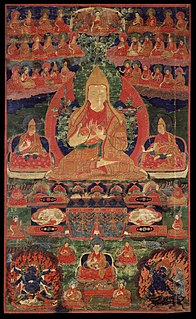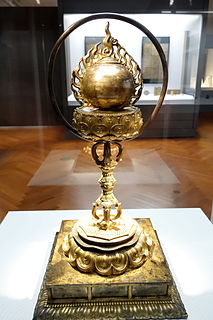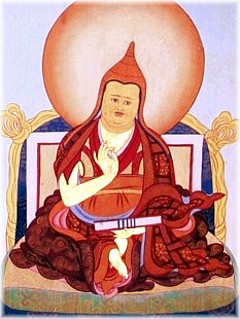External links
- Audio Interview Series on BuddhistGeeks.com
- Jeffrey Hopkins - UVA Tibet Center
- UMA Tibet's Collection of Jeffrey Hopkins Video Lectures
Jeffrey Hopkins (born 1940) is an American Tibetologist. He is Emeritus professor of Tibetan and Buddhist Studies at the University of Virginia, where he taught for more than three decades since 1973. [1] He has authored more than twenty-five books about Tibetan Buddhism, among them the highly influential Meditation on Emptiness, [2] which appeared in 1983, offering a pioneering exposition of Prasangika-Madyamika thought in the Geluk tradition. From 1979 to 1989 he was the Dalai Lama's chief interpreter into English [3] and he played a significant role in the development of the Free Tibet Movement. [4] In 2006 he published his English translation of a major work by the Jonangpa lama, Dolpopa, on the Buddha Nature and Emptiness called Mountain Doctrine. [5]

Tibetan Buddhism is the form of Buddhism practiced in Tibet and Bhutan, where it is the dominant religion. It also has adherents in the regions surrounding the Himalayas, in much of Central Asia, in the Southern Siberian regions such as Tuva, and in Mongolia.

The Gelug is the newest of the four major schools of Tibetan Buddhism. It was founded by Je Tsongkhapa (1357–1419), a Tibetan philosopher, tantric yogi and lama and further expanded and developed by his disciples.
The relationship between Buddhism and science is a subject of contemporary discussion and debate among Buddhists, scientists and scholars of Buddhism. Historically, Buddhism encompasses many types of beliefs, traditions and practices, so it is difficult to assert any single "Buddhism" in relation to science. Similarly, the issue of what "science" refers to remains a subject of debate, and there is no single view on this issue. Those who compare science with Buddhism may use "science" to refer to "a method of sober and rational investigation" or may refer to specific scientific theories, methods or technologies.

Kālacakra is a polysemic term in Vajrayana Buddhism that means "wheel of time" or "time cycles". "Kālacakra" is also the name of a series of Buddhist texts and a major practice lineage in Indian Buddhism and Tibetan Buddhism. The tantra is considered to belong to the unexcelled yoga (anuttara-yoga) class.

The Jonang is one of the schools of Tibetan Buddhism. Its origins in Tibet can be traced to early 12th century master Yumo Mikyo Dorje, but became much wider known with the help of Dolpopa Sherab Gyaltsen, a monk originally trained in the Sakya school. The Jonang schools main practice is highest practice of Vajrayan which is the Kalchakara Teaching.
In Mahayana Buddhism, bodhicitta,, is the mind (citta) that is aimed at awakening (bodhi), with wisdom and compassion for the benefit of all sentient beings. Bodhicitta is the defining quality of the Mahayana bodhisattva and the act of giving rise to bodhicitta (bodhicittotpāda) is what makes a bodhisattva a bodhisattva. The Daśabhūmika Sūtra explains that the arising of bodhicitta is the first step in the bodhisattva's career.

Buddha-nature is a doctrine in Mahayana Buddhism that ordinary people are in some way inherently the same as a Buddha. Many other schools of Buddhism have related doctrines but the precise interpretations vary widely, even within the various Mahayana traditions. Buddha-nature refers to several related Buddhist terms, most notably tathāgatagarbha and buddhadhātu. Tathāgatagarbha means "the womb" or "embryo" (garbha) of the "thus-gone" (tathāgata), or "containing a tathāgata", while buddhadhātu literally means "Buddha-realm" or "Buddha-substrate".
Lamrim is a Tibetan Buddhist textual form for presenting the stages in the complete path to enlightenment as taught by Buddha. In Tibetan Buddhist history there have been many different versions of lamrim, presented by different teachers of the Nyingma, Kagyu and Gelug schools. However, all versions of the lamrim are elaborations of Atiśa's 11th-century root text A Lamp for the Path to Enlightenment (Bodhipathapradīpa).

Tsongkhapa was an influential Tibetan Buddhist monk, philosopher and tantric yogi, whose activities led to the formation of the Gelug school of Tibetan Buddhism. He is also known by his ordained name Losang Drakpa or simply as "Je Rinpoche". He is also known by Chinese as Zongkapa Lobsang Zhaba or just Zōngkàbā (宗喀巴).

The Rimé movement is a movement or tendency in Tibetan Buddhism which promotes non-sectarianism and universalism. Teachers from all branches of Tibetan Buddhism - Sakya, Kagyu, Nyingma and Gelug, as well as Bon - have been involved in the promoting Rimé ideals.

Jamgön Ju Mipham Gyatso, or Mipham Jamyang Namgyal Gyamtso (1846–1912) was a very influential philosopher and polymath of the Nyingma school of Tibetan Buddhism. He wrote over 32 volumes on topics such as painting, poetics, sculpture, alchemy, medicine, logic, philosophy and tantra. Mipham's works are still central to the scholastic curriculum in Nyingma monasteries today. Mipham is also considered one of the leading figures in the Ri-me (non-sectarian) movement in Tibet.

Khenpo Tsültrim Gyamtso Rinpoche is a prominent scholar yogi in the Kagyu tradition of Tibetan Buddhism. He teaches widely in the West, often through songs of realization, his own as well as those composed by Milarepa and other masters of the past. "Tsültrim Gyamtso" translates to English as "Ocean of Ethical Conduct".

Dölpopa Shérap Gyeltsen (1292–1361), known simply as Dölpopa, was a Tibetan Buddhist master. Known as "The Buddha from Dölpo," a region in modern Nepal, he was the principal exponent of the shentong teachings, and an influential member of the Jonang tradition of Tibetan Buddhism.
Ngawang Wangyal, aka Sogpo (Mongolian) Wangyal, popularly known as Geshe Wangyal and "America's first lama," was a Buddhist lama and scholar of Kalmyk origin. He was born in the Astrakhan province in southeast Russia sometime in 1901 and died in West Palm Beach, Florida in 1983. He came to the United States from Tibet in 1955 and was the spiritual leader of the Kalmuk Buddhist community in Freewood Acres, New Jersey at the Rashi Gempil-Ling Buddhist Temple. He is considered a "founding figure" of Buddhism in the West.

Tibetan tantric practice, also known as "the practice of secret mantra", and "tantric techniques", refers to the main tantric practices in Tibetan Buddhism. The great Rime scholar Jamgön Kongtrül refers to this as "the Process of Meditation in the Indestructible Way of Secret Mantra" and also as "the way of mantra," "way of method" and "the secret way" in his Treasury of Knowledge. These Vajrayāna Buddhist practices are mainly drawn from the Buddhist tantras and are generally not found in "common" Mahayana. These practices are seen by Tibetan Buddhists as the fastest and most powerful path to Buddhahood.

Abhayākaragupta was a Buddhist monk, scholar and tantric master (vajracarya) and the abbot of Vikramasila monastery in modern-day, Bihar in India. He was born in somewhere in Eastern India, and is thought to have flourished in the late 11th-early 12th century CE, and died in 1125.
Purity is an important concept within much of Theravada and Mahayana Buddhism, although the implications of the resultant moral purification may be viewed differently in the varying traditions. The aim is to purify the personality of the Buddhist practitioner so that all moral and character defilements and defects are wiped away and nirvana can be obtained.
Guy Martin Newland is a scholar of Tibetan Buddhism who has been a professor at Central Michigan University in Mount Pleasant, Michigan since 1988. He served as Chairperson of Central Michigan University's Department of Philosophy and Religion during the periods 2000–2003, 2006–2009, and 2016-. He was elected to the Mount Pleasant Board of Education in July 2003 and served until December 2007, including six months as President of the Board and one year as Secretary.
Elizabeth Napper is the author of Dependent-Arising and Emptiness, A Tibetan Buddhist Interpretation of Madhyamika Philosophy, Emphasizing the Compatibility of Emptiness and Conventional Phenomena. She has a PhD in Buddhist Studies from the University of Virginia. The book is based on her PhD thesis, supported by a Fulbright-Hays Doctoral Dissertation Research Fellowship.
Rangtong and shentong are two distinctive views on emptiness (sunyata) and the two truths doctrine within Tibetan Buddhism.